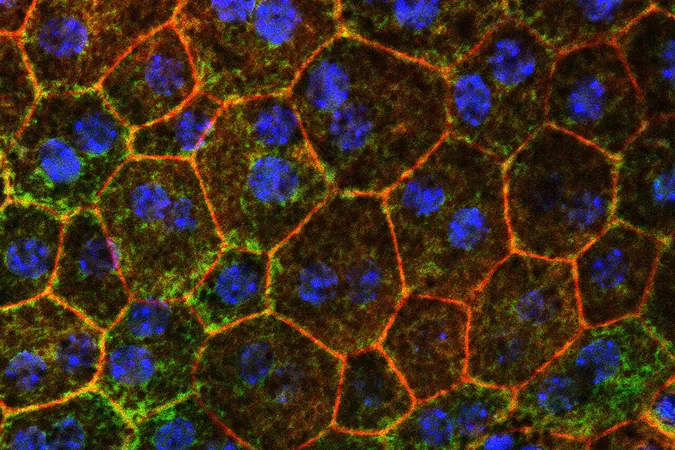
Revolutionary Breakthrough: Fixing Cholesterol Metabolism to Prevent Blindness!
2025-06-24
Author: John Tan
A New Hope for Vision Preservation
A groundbreaking study from Washington University School of Medicine in St. Louis reveals a potential game-changer in the fight against age-related macular degeneration (AMD), a leading cause of vision loss in people over 50. Published in *Nature Communications*, the research sheds light on the critical role cholesterol metabolism plays in this debilitating condition.
Cholesterol Metabolism and Eye Health: The Connection
The WashU Medicine team, collaborating with international researchers, has identified that cholesterol processing issues may underlie the progression of AMD. This discovery opens up new avenues for understanding the complex links between eye health and cardiovascular disease, both of which deteriorate with age.
Apolipoprotein M: The Key to Mitigating AMD?
The researchers found that elevating levels of a molecule known as apolipoprotein M (ApoM) in the bloodstream might rectify the cholesterol processing issues leading to cellular damage in the eyes and other vital organs. Increasing ApoM could pave the way for innovative treatment strategies for AMD and possibly various forms of heart failure rooted in similar cholesterol dysfunction.
Senior author Dr. Rajendra S. Apte emphasizes the significance of these findings, pointing out the current limitations of therapies that only address advanced stages of macular degeneration and do not reverse the disease. “By focusing on increasing ApoM, we might not only treat but potentially prevent AMD, thus safeguarding vision as people age,” he stated.
Understanding Macular Degeneration
During eye examinations, doctors can identify cholesterol-rich deposits beneath the retina that signal the onset of macular degeneration. Early stages may not affect vision significantly, but the buildup intensifies inflammation and leads to a gradual decline in central vision. The most common form, dry AMD, can result in geographic atrophy, similar to neurodegeneration seen in Alzheimer’s patients. This can progress to the more severe wet type, characterized by abnormal blood vessel growth and significant vision impairment.
The Role of ApoM in Aging and Disease
Recent evidence highlights ApoM's protective properties and anti-inflammatory effects in maintaining healthy cholesterol levels. Dr. Apte and co-author Dr. Ali Javaheri noticed that ApoM levels decrease with age and that patients with AMD exhibit lower ApoM levels compared to healthy individuals. Their earlier research has also linked reduced ApoM to heart failure.
Exciting Research Findings
Their study discovered that ApoM is crucial for the pathways that eliminate excess, harmful cholesterol from the body. When ApoM is deficient, essential cells in both the retina and heart struggle to process cholesterol effectively, leading to dangerous lipid accumulation and inflammation.
To test whether boosting ApoM levels could counteract damage, the researchers enhanced ApoM in mouse models through genetic alteration and plasma transfer. Results were promising, showing marked improvement in retinal health, enhanced functionality of light-sensing cells, and reduced cholesterol buildup. They discovered that ApoM activates a vital signaling pathway that helps break down cholesterol in lysosomes, key components in cellular waste disposal.
Future Implications and Developments
The journey doesn’t stop here. Dr. Apte and Dr. Javaheri are collaborating with Mobius Scientific, a WashU startup aiming to leverage this newfound knowledge into potential therapies for AMD prevention. They believe that the connections discovered between retinal and heart muscle cells, both affected by low ApoM, could lead to groundbreaking interventions for heart-related conditions as well.
This innovative research could be the beacon of hope for millions looking to preserve their vision and health in the face of aging.


 Brasil (PT)
Brasil (PT)
 Canada (EN)
Canada (EN)
 Chile (ES)
Chile (ES)
 Česko (CS)
Česko (CS)
 대한민국 (KO)
대한민국 (KO)
 España (ES)
España (ES)
 France (FR)
France (FR)
 Hong Kong (EN)
Hong Kong (EN)
 Italia (IT)
Italia (IT)
 日本 (JA)
日本 (JA)
 Magyarország (HU)
Magyarország (HU)
 Norge (NO)
Norge (NO)
 Polska (PL)
Polska (PL)
 Schweiz (DE)
Schweiz (DE)
 Singapore (EN)
Singapore (EN)
 Sverige (SV)
Sverige (SV)
 Suomi (FI)
Suomi (FI)
 Türkiye (TR)
Türkiye (TR)
 الإمارات العربية المتحدة (AR)
الإمارات العربية المتحدة (AR)